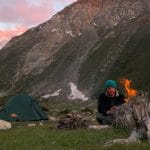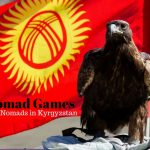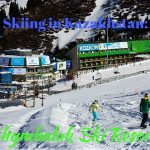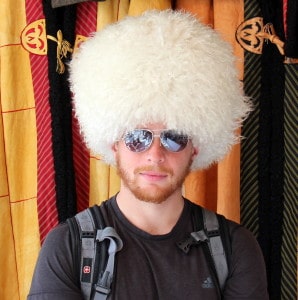Saving Snow Leopards in Kyrgyzstan:
the NABU Rehabilitation Center
Alternate Title: Gratuitous Pictures of Snow Leopards
The whole thing started, really, with a ‘Special Exhibition on Snow Leopards’ in the Kyrgyzstan State Museum of Fine Arts. Walking through those quiet halls looking at a hundred-odd photos and drawings snow leopards made by artists from across Kyrgyzstan there really can only be one overriding though: “I want to go to there.”
It took several months, a lot of research, a new job title, and more than a bit of “show up and hope for the best” but in the end: Snow Leopards! Gratuitous snow leopards. Snow leopards sunning and playing and stalking and frolicking. All the snow leopard once could hope for, in fact, outside of that rare chance encounter in the actual wild.
Statistics are hard to come by, but experts estimate that there were around 660 snow leopards present in the territory of modern Kyrgyzstan as of 1990 (the second-largest population in the world). Though hunting had been forbidden by Soviet authorities from 1950 forward, there were small allowances for authorities to catch live snow leopards and export them to zoos around the world. With the dissolution of the Soviet Union, however, it is believed that with a lack of enforcement of anti-poaching laws between 50-80% of the country’s Snow Leopard population disappeared in the 1990’s alone. Despite their strength and stealth and far-removed-from-humans lifestyle, the snow leopards themselves were simply not up to the task of fending off predatory humans in their environment. (Information almost directly from the NABU website.)
Enter: NABU. The ‘German Society for Nature Conservation’ became in 1999 the first international organization to sign a bi-lateral agreement with the government of Kyrgyzstan on the conservation of snow leopards. Their most publicized efforts center on the investigation and prosecution of poaching in the country, with quite a few stories of arrests ranging from private citizens of the Issyk-Kol region caught selling snow leopard hides all the way up to members of the Kyrgyz Secret Service attempting to offload two injured but live animals.
In the first four years after being founded, the ‘Snow Leopard Enforcement Team’ recovered three live animals and sixteen hides – all of which are illegal to trade under Kyrgyz law. The less-asked question, though, is: “What happens to a confiscated snow leopard?” As it turns out, NABU holds the answer to that one as well.
In the mountains above the village of Ananyevo, on the northern shore of Issyk-Kol, the NABU Rehabilitation Center for Wild Animals is currently home to five snow leopards – both wild-born and captive-bred. Originally built to house and care for those three leopards confiscated from poachers by the ‘Gruppa Bars‘ enforcement team, it was with some surprise that the caretakers at the NABU Center realized that their leopards were breeding!
Of the five snow leopards currently resident at the NABU Rehabilitation Center, three were so grievously injured during their capture by poachers that they were deemed unable to cope if released back into the wild and so will live out their days in the enclosure. The others, perhaps an even sadder story, were born into captivity and thus never developed skills like hunting that would be essential to a life in the wild. They, too, seem to be in it for the long haul. Unable to return these captive animals to their native habitats, NABU continues to prioritize most of its efforts in the country towards protecting those wild populations that do still exist and allowing them to naturally rebuild their numbers.
Yet, arriving to the snow leopard enclosure at the NABU center for the first time and actually getting a glimpse of real live Snow Leopards, this is easy to forget. While the two older leopards are fairly calm and spend a lot of time laying around near the feeding house, the three young siblings jump and play and pounce and hide. Whether while being stealthily stalked from the other side of tall grass (safely outside the thick metals bars of their enclosure, to be sure) or as one of the animals comes right up to the edge to roll belly-up in that “Scratch me!” gesture that every cat I’ve ever known has at times attempted, these endangered grey fur-balls seem almost cuddly.
Almost. Until another comes to the fence and grows so deeply I can feel it in the very depths of my stomach. Until, out of nowhere, one sibling spring upon another with a flying leap that would take even the hardiest of humans well below their comfortable level of intact limbs. These are still wild animals, despite the fact that they live in captivity. Dangerous and beautiful and strong; with any luck strong enough that with the human assistance that groups like NABU provide the Snow Leopard will again prosper in the high mountains of countries like Kyrgyzstan.
If you would like to support Snow Leopard Conservation and NABU specifically, you can visit their website to become a ‘Snow Leopard Godfather’ by sponsoring one of the animals at their facility in Kyrgyzstan. NABU isn’t the only organization protecting snow leopards in Kyrgyzstan, however, so check back in the next couple of weeks for more information on an ongoing story I’m working on with the Snow Leopard Trust as well! (Or, if you’re hurting for even more pictures of snow leopards, my photography portfolio will have to do for now!)
Practical Information:
The NABU Rehabilitation Center for Wild Animals is in the mountains above the village of Ananyevo on the north shore of lake Issyk-Kol. You’ll have to get permission from the head of the center, Director Kylagin, if you want to visit. He is known by reputation in the village and somebody should be able to either call him for you or point you to where you can find him.
The center itself is quite a few kilometers in from the main road and not at all obvious to find, so it would be worth asking around for a driver that is already confident of the way.
Most people will visit from either Cholpon Ata or Karakol, or perhaps en route between the two. There are hostels in Cholpon Ata and a number of guesthouses in Karakol, so the question is really one of whether you value spending time in the mountains of Karakol (about 80k away from Ananyevo) or the beaches of Cholpon Ata (about a 40k drive from Ananyevo).















I hope this beautiful “cat” specie will be saved. It would have been great if we still had the Caspian Tiger and others alive…
On the surface they appear to be trying hard. Protecting habitat, passing laws against poachers, stuff like that. The question remains how much effect that will have in the long term though, and whether they have the ongoing resources and political will to enfore all these things out in the real world.
Hey bro. thanks for that info on reaching issyk ata springs in january. was awesome!
i’ve been to visit tolkunbek, director of NABU in bishkek. he said it was cool for me to visit the rehabilitation centre. he advised april as the best time and said he’ll put me in touch kulagin the director of the centre itself. he’s drawn me a map on paper saying it’s about a 10-12km hike north from a signpost just after (or possibly before) Ananevo village. Just wondering how you visited and was it difficult? Tolkunbek said if he visits in April i can hitch a lift with him but if not I have to find my own way there and let Kulagin know beforehand.
As before, any info would be awesome. Thanks man>
Adam
Hi,
unless you NABU guys deal wit REAL issues, such as lack of habitat, economic growth fallacy,
failed development aid, poverty, and with EU resource consumption issues, and certainly your own structure and wealth (German and NGO and your salaries, social benefits) you are just spewing out propaganda here; the usual stuff.
Snow leopards will be the last ones who win in that, or subsistence societies.
From that, I think you guys have learned nothing, not even from your own history, WW2, colonialism and communism that is. We see here just another shiny capitalism outlet, German-style.
It’s really sickening to see this, and people still keep doing it.
Perhaps focus on poodles and hamsters, if that works there perhaps; but certainly not wilderness issues or climate
(just in case that matters).
In deep shock to see all this
Falk Huettmann
Hi Falk,
You are welcome to address your comments directly to NABU, but it has no place here.
Regards,
Stephen